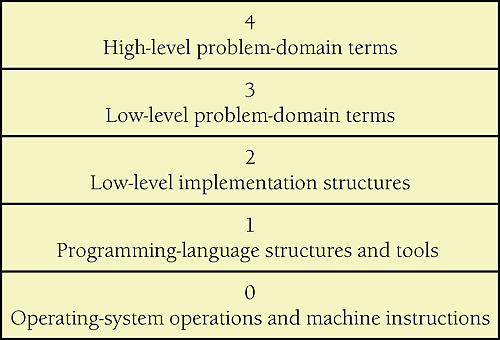34.6. Program in Terms of the Problem Domain
| < Free Open Study > |
| Another specific method of dealing with complexity is to work at the highest possible level of abstraction. One way of working at a high level of abstraction is to work in terms of the programming problem rather than the computer-science solution. Top-level code shouldn't be filled with details about files and stacks and queues and arrays and characters whose parents couldn't think of better names for them than i, j, and k. Top-level code should describe the problem that's being solved. It should be packed with descriptive class names and routine calls that indicate exactly what the program is doing, not cluttered with details about opening a file as "read only." Toplevel code shouldn't contain clumps of comments that say "i is a variable that represents the index of the record from the employee file here, and then a little later it's used to index the client account file there." That's clumsy programming practice. At the top level of the program, you don't need to know that the employee data comes as records or that it's stored as a file. Information at that level of detail should be hidden. At the highest level, you shouldn't have any idea how the data is stored. Nor do you need to read a comment that explains what i means and that it's used for two purposes. You should see different variable names for the two purposes instead, and they should also have distinctive names such as employeeIndex and clientIndex. Separating a Program into Levels of AbstractionObviously, you have to work in implementation-level terms at some level, but you can isolate the part of the program that works in implementation-level terms from the part that works in problem-domain terms. If you're designing a program, consider the levels of abstraction shown in Figure 34-1. Figure 34-1. Programs can be divided into levels of abstraction. A good design will allow you to spend much of your time focusing on only the upper layers and ignoring the lower layers Level 0: Operating-System Operations and Machine InstructionsIf you're working in a high-level language, you don't have to worry about the lowest level your language takes care of it automatically. If you're working in a low-level language, you should try to create higher layers for yourself to work in, even though many programmers don't do that. Level 1: Programming-Language Structures and ToolsProgramming-language structures are the language's primitive data types, control structures, and so on. Most common languages also provide additional libraries, access to operating system calls, and so on. Using these structures and tools comes naturally since you can't program without them. Many programmers never work above this level of abstraction, which makes their lives much harder than they need to be. Level 2: Low-Level Implementation StructuresLow-level implementation structures are slightly higher-level structures than those provided by the language itself. They tend to be the operations and data types you learn about in college courses in algorithms and data types: stacks, queues, linked lists, trees, indexed files, sequential files, sort algorithms, search algorithms, and so on. If your program consists entirely of code written at this level, you'll be awash in too much detail to win the battle against complexity. Level 3: Low-Level Problem-Domain TermsAt this level, you have the primitives you need to work in terms of the problem domain. It's a glue layer between the computer-science structures below and the highlevel problem-domain code above. To write code at this level, you need to figure out the vocabulary of the problem area and create building blocks you can use to work with the problem the program solves. In many applications, this will be the business objects layer or a services layer. Classes at this level provide the vocabulary and the building blocks. The classes might be too primitive to be used to solve the problem directly at this level, but they provide a framework that higher-level classes can use to build a solution to the problem. Level 4: High-Level Problem-Domain TermsThis level provides the abstractive power to work with a problem on its own terms. Your code at this level should be somewhat readable by someone who's not a computer-science whiz, perhaps even by your nontechnical customer. Code at this level won't depend much on the specific features of your programming language because you'll have built your own set of tools to work with the problem. Consequently, at this level your code depends more on the tools you've built for yourself at Level 3 than on the capabilities of the language you're using. Implementation details should be hidden two layers below this one, in a layer of computer-science structures, so that changes in hardware or the operating system don't affect this layer at all. Embody the user's view of the world in the program at this level because when the program changes, it will change in terms of the user's view. Changes in the problem domain should affect this layer a lot, but they should be easy to accommodate by programming in the problem-domain building blocks from the layer below. In addition to these conceptual layers, many programmers find it useful to break a program up into other "layers" that cut across the layers described here. For example, the typical three-tier architecture cuts across the levels described here and provides further tools for making the design and code intellectually manageable. Low-Level Techniques for Working in the Problem DomainEven without a complete, architectural approach to working in the problem area's vocabulary, you can use many of the techniques in this book to work in terms of the real-world problem rather than the computer-science solution:
|
| < Free Open Study > |
EAN: 2147483647
Pages: 334